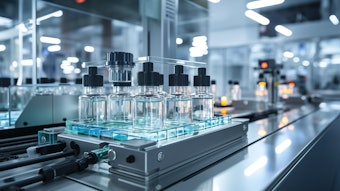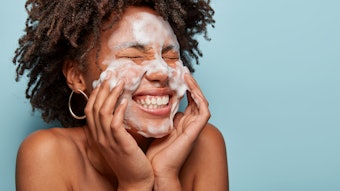
In the last two decades, with the advent and advancement of genetic and cellular engineering, progressively more effort has been put into recombinant collagen production, including for skin and hair care. How? and Why? This article answers these questions and details the results of ex vivo and in vivo studies of human collagen III-inspired, vegan and fermented recombinant 50 kDa protein to understand its skin benefits.
Log in to view the full article
In the last two decades, with the advent and advancement of genetic and cellular engineering, progressively more effort has been put into recombinant collagen production, including for skin and hair care. How? and Why? This article answers these questions and details the results of ex vivo and in vivo studies of human collagen III-inspired, vegan and fermented recombinant 50 kDa protein to understand its skin benefits.
Collagen is the most abundant protein in the human body and present in connective tissues such as cartilage, bones, tendons, ligaments and skin.1 The collagen superfamily comprises 28 members, of which type I collagen is the most abundant form (~80-85% of total collagen). Also a major protein in the extracellular matrix (ECM) of human cells, collagen I assembles into fibers that form the structural and mechanical scaffold (matrix) of skin and other connective tissues.
Collagen type III is the second most abundant collagen (~10-15% of total collagen) that is primarily produced by young fibroblasts before the tougher type I collagen is synthesized.2 Collagen III is found in granulation tissue as well as in artery walls, skin, intestines and the uterus.3-5
Both collagen I and III are fibrillar collagens that form higher order structures (fibrils, fibers and bundles) but they have slightly different structural properties. Type I collagen tends to form densely packed fibrils and a rigid triple helix for structure building. On the other hand, type III collagen forms a more flexible triple helical structure that assembles into small fibrils that are associated with the more rigid collagen I fibrils. As a result, collagen III functions as a modulator of overall tissue elasticity and function. Indeed, the ratio of collagen I/III correlates with skin aging and elasticity.6-9
Type I collagen is frequently used as a supplement in cosmetic products. While most commercial forms are derived from mammals such as bovine or porcine, other animal sources such chicken, fish skin and jellyfish have also been reported.10-16 Although animal-derived collagen is generally abundant and relatively inexpensive, it can suffer drawbacks such as the risk of infectious disease transmission, potential viral vector transmission from animal to human, allergenicity and unpleasant smell and color.17 Non-type I collagens, such as type III collagen, tend to be scarcer and more expensive due to the challenges of sourcing sufficient protein quantities and purifying them from natural sources.18
In the last two decades, with the advent of and advancement of genetic and cellular engineering, progressively more effort has been put into recombinant collagen production. Recombinant collagen molecules of different sizes have been expressed in all major platforms including mammalian cells, insect cells, yeast, bacteria and plant cells.19-37 In general, high quality, full-length collagen proteins have been produced in eukaryotic hosts but with low productivity.
Prokaryotic hosts such as E. coli have also been explored for the production of unmodified collagen although these recombinant proteins are generally either very small (a few kDa up to 20 kDa) or have been extensively modified from wild-type human collagen sequences. It is well-known that prokaryotic hosts lack the post-translational modification functions needed to generate the hydroxyproline amino acid residues found in mature animal-derived collagen. As such, previously produced recombinant collagen proteins generally only exhibit an unmodified collagen sequence.38-40
References
- Ricard-Blum, S., (2011). The collagen family. Cold Spring Harb Perspect Biol. 3, a004978.
- Fleischmajer, R., MacDonald, E.D., Perlish, J.S., Burgeson, R.E. and Fisher, L.W. (1990). Dermal collagen fibrils are hybrids of type I and type III collagen molecules. J Struct Biol. 105 162-169.
- Kuivaniemi, H. and Tromp, G. (2019). Type III collagen (COL3A1): Gene and protein structure, tissue distribution and associated diseases. Gene. 707 151-171.
- Nielsen, M.J. and Karsdal, M.A. (2016). Type III Collagen. in Biochemistry of Collagens, Laminins and Elastin, 1st edn. Karsdal, M.A. Academic Press, Cambridge, MA, USA. pp 21-30.
- Manturova, G.O., Smirnova, V.A., Stupin, E.V. and Silina, N.E. (2018). The ratio of collagen types I/III as a marker of skin aging and prognosis of aesthetic facial surgery results. J Pharm Sci & Res. 10 2543-2546.
- Wang, C., Rong, Y., Ning, F. and Zhang, G. (2011). The content and ratio of type I and III collagen in skin differ with age and injury. African Journal of Biotechnology. 10 2524-2529.
- Parkin, J.D., San Antonio, J.D., ... Savige, J., et al. (2017). The collgen III fibril has a "flexi-rod" structure of flexible sequences interspersed with rigid bioactive domains including two with hemostatic roles. PLoS One. 12 e0175582.
- Liu, X., Wu, H., Byrne, M., Krane, S. and Jaenisch, R. (1997). Type III collagen is crucial for collagen I fibrillogenesis and for normal cardiovascular development. Proc Natl Acad Sci USA. 94 1852-1856.
- Wang, C., Brisson, B.K., ... Han, L., et al. (2020). Type III collagen is a key regulator of the collagen fibrillar structure and biomechanics of articular cartilage and meniscus. Matrix Biol. 85-86 47-67.
- Cliche, S., Amiot, J., Avezard, C. and Gariépy, C. (2003). Extraction and characterization of collagen with or without telopeptides from chicken skin. Poult Sci. 82 503-509.
- Munasinghe, K.A., Schwarz, J.G. and Nyame, A.K. (2014). Chicken collagen from law market value by-products as an alternate source. J Food Processing. https://doi.org/10.1155/2014/298295
- Zhou, C., Li, Y., ... Out, P.N.Y., et al. (2016). Extraction and characterization of chicken feet soluble collagen. LWT - Food Science and Technology. http://dx.doi.org/10.1016/j.lwt.2016.07.024.
- Jafari, H., Lista, A., ... Shavandi, A., et al. (2020). Fish collagen: Extraction, characterization and applications for biomaterials engineering. Polymers (Basel). 12 2230.
- O'Sullivan, A., Shaw, N.B., Murphy, S.C., van de Vis, J.W., van Pelt-Heerschap, H. and Kerry, J.P. (2006). Extraction of collagen from fish skins and its use in the manufacture of biopolymer jilms. J Aquatic Food Product Tech. 15 21-32.
- Khong, N.M.H., Yusoff, F.M., ... Nishikawa, J., et al. (2018). Improved collagen extraction from jellyfish (Acromitus hardenbergi) with increased physical-induced solubilization processes. Food Chem. 251 41-50.
- Coppola, D., Oliviero, M., ... de Pascale, D., et al. (2020). Marine collagen from alternative and sustainable sources: Extraction, processing and applications. Mar Drugs. 18 214; doi:10.3390/md18040214
- Browne, S., Zeugolis, D.I. and Pandit, A. (2013). Collagen: Finding a solution for the source. Tissue Eng Part A. 19 1491-1494.
- Asgari, M., Latifi, N., Heris, H.K., Vali, H. and Mongeau, L. (2017). In vitro fibrillogenesis of tropocollagen type III in collagen type I affects its relative fibrillar topology and mechanics. Sci Rep. 7 1392; 10.1038/s41598-017-01476-y
- Fertala, A. (2020). Three decades of research on recombinant collagens: Reinventing the wheel or developing new biomedical products? Bioengineering (Basel). 7; 10.3390/bioengineering7040155
- Schnieke, A., Dziadek, M., ... Jaenisch, R., et al. (1987). Introduction of the human pro alpha 1(I) collagen gene into pro alpha 1(I)-deficient Mov-13 mouse cells leads to formation of functional mouse-human hybrid type I collagen. Proc Natl Acad Sci USA. 84 764-768.
- Olsen, A.S., Geddis, A.E. and Prockop, D.J. (1991). High levels of expression of a minigene version of the human pro alpha 1 (I) collagen gene in stably transfected mouse fibroblasts. Effects of deleting putative regulatory sequences in the first intron. J Biol Chem. 266 1117-1121.
- Specks, U., Mayer, U., ... Chu, M.L., et al. (1992). Structure of recombinant N-terminal globule of type VI collagen alpha 3 chain and its binding to heparin and hyaluronan. EMBO J. 11 4281-4290.
- Mazzorana, M., Gruffat, H., Sergeant, A. and van der Rest, M. (1993). Mechanisms of collagen trimer formation. Construction and expression of a recombinant minigene in HeLa cells reveals a direct effect of prolyl hydroxylation on chain assembly of type XII collagen. J Biol Chem. 268 3029-3032.
- Fertala, A., Sieron, A.L., ... Prockop, D.J., et al. (1994). Synthesis of recombinant human procollagen II in a stably transfected tumour cell line (HT1080). Biochem J. 298 31-37.
- Olsen, D., Yang, C., ... Polarek, J., et al. (2003). Recombinant collagen and gelatin for drug delivery. Adv Drug Deliv Rev. 55 1547-1567.
- Fertala, A., Shah, M., Hoffman, R. and Arnold, W.V. (2016). Designing recombinant collagens for biomedical applications. Curr Tissue Eng. 5 73-84.
- Bulleid, N.J., John, D.C. and Kadler, K.E. (2000). Recombinant expression systems for the production of collagen. Biochem Soc Trans. 28 350-353.
- Ruggiero, F., Exposito, J.Y., ... Theisen, M., et al. (2000). Triple helix assembly and processing of human collagen produced in transgenic tobacco plants. FEBS Lett. 469 132-136.
- Xu, X., Gan, Q., ... Wang, K., et al. (2011). Hydroxylation of recombinant human collagen type I alpha 1 in transgenic maize co-expressed with a recombinant human prolyl 4-hydroxylase. BMC Biotechnol. 11 69.
- Gellermann, P., Schneider-Barthold, C., Bolten, S.N., Overfelt, E., Scheper, T. and Pepelanova, I. (2019). Production of a recombinant non-hydroxylated gelatin mimetic in Pichia pastoris for biomedical applications. J Funct Biomater. 10 39.
- Rutschmann, C., Baumann, S., Cabalzar, J., Luther, K.B. and Hennet, T. (2014). Recombinant expression of hydroxylated human collagen in Escherichia coli. Appl Microbiol Biotechnol. 98 4445-4455.
- John, D.C., Watson, R., Kind, A.J., Scott, A.R., Kadler, K.E. and Bulleid, N.J. (1999). Expression of an engineered form of recombinant procollagen in mouse milk. Nat Biotechnol. 17 385-389.
- Weber, S.C. and Herz, A.H. (1998, Jan 20). Method for recombinant yeast expression and isolation of water-soluble collagen-type polypeptides. U.S. Pat App 383,748; U.S. Pat 5,710,252.
- Mashiko, T., Takada, H., ... Yoshimura, K., et al. (2018). Therapeutic effects of a recombinant human collagen peptide bioscaffold with human adipose-derived stem cells on impaired wound healing after radiotherapy. J Tissue Eng Regen Med. 12 1186-1194.
- Shi, J., Ma, X., ... Xue, W., et al. (2017). Hydroxylation of human type III collagen alpha chain by recombinant coexpression with a viral prolyl 4-hydroxylase in Escherichia coli. Protein J. 36 322-331.
- Vuorela, A., Myllyharju, J., Nissi, R., Pihlajaniemi, T. and Kivirikko, K.I. (1997). Assembly of human prolyl 4-hydroxylase and type III collagen in the yeast Pichia pastoris: Formation of a stable enzyme tetramer requires coexpression with collagen and assembly of a stable collagen requires coexpression with prolyl 4-hydroxylase. EMBO J. 16 6702-6712.
- Báez, J., Olsen, D. and Polarek, J.W. (2005). Recombinant microbial systems for the production of human collagen and gelatin. Appl Microbiol Biotechnol. 69 245-252.
- Sipilä, K.H., Drushinin, K., ... Heino, J., et al. (2018). Proline hydroxylation in collagen supports integrin binding by two distinct mechanisms. J Biol Chem. 293 7645-7658.
- Rappu, P., Salo, A.M., Myllyharju, J. and Heino, J. (2019). Role of prolyl hydroxylation in the molecular interactions of collagens. Essays Biochem. 63 325-335.










